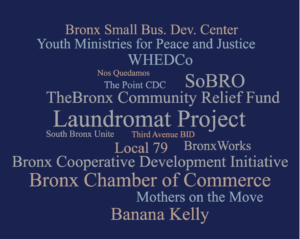I am surprised by the sheer number of organizations that have a mission and target-area similar to WHEDco’s. In order to get a better understanding of the “field” that WHEDco operates in, I started to make a list of organizations that I came across who work with community development in the South Bronx. I’ve inserted this below as a word cloud.

Each of these organizations, on their own, hold an immense amount of power to act and make change. For example, the Bronx Rising Initiative secured and distributed over $200,000 in grant funding to Bronx-based small businesses that were negatively impacted by the COVID-19 pandemic. In 2020, BronxWorks enrolled over 24,000 new Bronx residents into their programs, providing health, education, homeless, and workforce services.
However, Nicole Marwell identifies that there are indeed boundaries on what kind of action is possible. From the field that WHEDco operates in, the boundaries on what kind of action is possible likely start to emerge when considering an even larger field consisting of stakeholders of the South Bronx.
WHEDco and its peer organizations embody such a similar narrative. That is what makes this level of collaborative activism possible. When I attend the Southern Boulevard Coalition meetings and the Bronx-Wide Platform Coordination meetings, representatives from each organization seem to be in agreement with sentiments around “collective self-determinism” and economic democracy, echoing one another frequently over the course of the meetings.
Even though it seems intuitive that there is power in numbers, and that collaboration across so many organizations will undoubtedly work to break boundaries, I feel that some bounds are ruptured and others are merely reinforced. In this “field”, WHEDco and its peers form a somewhat insular bubble, and I’m interested in how this corner of the field interacts with other parts of the field.
Back to the original inquiry – What is one way in which the bounds on what kinds of action are possible might be ruptured?
An inter-organizational space such as the Southern Boulevard Coalition successfully brings together diverse people with experience in different nonprofits. It also multiplies the number of relationships between people in the field, and in the community. People being more in relationship to one another makes it easier to propagate resources, create flow between communities, and advocate for change. And that, I’d like to believe, will give the boundaries formed by historical power structures and long-term marginalization “some space to breath”.

That’s great that you are getting to see these broader coalitions in action. Coalitions can certainly be a strong positive force for change and help to break boundaries. I’d be curious if you’ve also seen any ways in which the coalitions bound individual actions and priorities. Are there compromises on priorities you’ve seen members make in order to keep the broader coalition together?